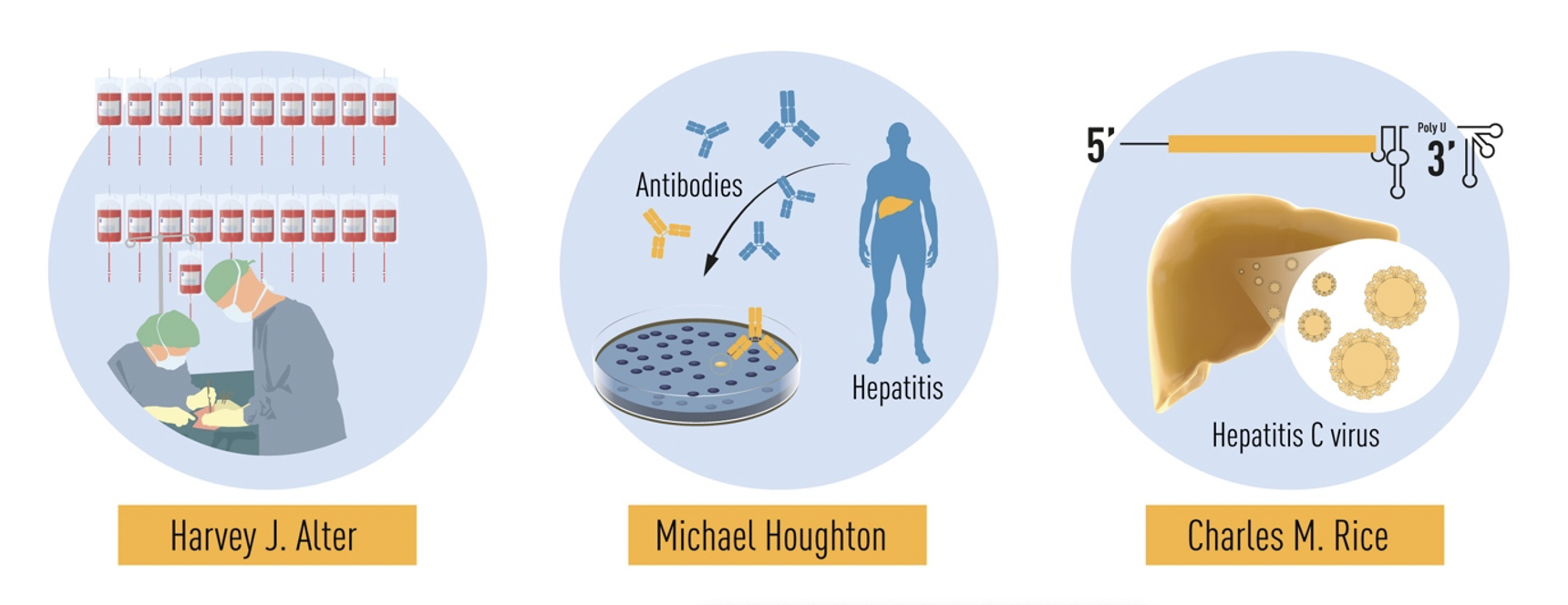It’s October, which is also known as the Nobel Prize season amongst scholars. The Nobel prize winner’s announcements began on Monday, October 5th, 2020, with the Physiology and Medicine category. The announcements began in Sweden, though due to the ongoing pandemic, some events usually organized by the Nobel Prize committee were cancelled.
This year’s Nobel prize winners for the category of Physiology or Medicine were Harvey J. Alter, Michael. Houghton and Charles M. Rice. They were jointly awarded the prize for their discovery of the Hepatitis C virus. They made a significant contribution to fight against the blood-borne disease. The discovery of Hepatitis C virus has definitely helped in unfolding the remaining cases of chronic hepatitis which has made it possible to save millions of lives and improve overall global health.
Harvey J Alter was born in 1953 in New York and graduated from Rochester Medical School. In the year 1961, he became a part of the National Institute of Health (NIH) team as a clinical associate. He joined NIH back in 1969 as a senior investigator in the Clinic Centre’s Department of Transfusion Medicine.
Michael Houghton is a British born doctorate degree holder from King’s College in London. He moved to California in the year 1982 and came to the University of Alberta in the year 2010. He is currently the Director and Research chair in Li Ka Shing Applied Virology Institute, as well as research chair at Canada Excellence.
Charles M. Rice was born in the year 1952 in Sacramento and got his PhD in the year 1981 from the California Institute of Technology. He founded his own research group at Washington University School of Medicine. He was the Scientific and Executive Director at the Centre for the study of Hepatitis C at Rockefeller University where he is currently active.
Hepatitis is looked at as a global threat to human health as it can cause cirrhosis, liver failure, liver damage, liver cancer or even death in severe cases. Hepatitis is also referred to as liver inflammation which is mainly caused by viral infections, although some other major disease-causing factors include alcohol abuse, autoimmune disease, environmental toxins, some medications etc. There are three most common hepatitis viruses Hepatitis A, Hepatitis B and Hepatitis C. Hepatitis B and C are transmitted via blood and bodily fluids and are considered pretty serious as in severe cases/chronic stages the development of cirrhosis and liver cancer can occur. This is because in some cases after a short-term infection, the virus stays in the body and causes a chronic infection. While on the other hand, Hepatitis A is transmitted through polluted food and water and is usually considered a short-term infection, depending on the cause and severity. Although the three types of viruses can show similar symptoms, the way they spread and affect an individual is different.
Bloodborne Hepatitis-C is considered dangerous since a healthy individual could be infected and would not necessarily be aware of its presence for several years until serious effects start showing up. Hepatitis C is also linked to morbidity and mortality at times because it causes more than a million deaths worldwide each year. It can range from mild to acute illness. Acute Hepatitis C usually occurs within 6 months of exposure to the Hepatitis C virus and is usually a short-term illness if not converted into the chronic infection. Chronic Hepatitis C on the contrary can be a life-long infection if it remains undetected, and could lead to serious diseases like cirrhosis, liver damage, liver cancer or death.
Identification was the first step to attain the goal. Michael Houghton isolated the genetic sequence of the virus and collected a collection of DNA fragments from nucleic acids found in the blood of an infected chimpanzee. Most of the fragments were taken from the genome of the chimpanzees but the research team suspected some to come from the unknown virus. The scientists used the hepatitis infected patient’s blood to identify cloned viral DNA fragments encoding viral proteins. After a lot of in-depth research, one positive clone was found. This clone was derived from an RNA virus which in turn was from the Flavivirus family and got named as the Hepatitis C virus.
The major hurdle in the process was to determine if the virus alone is causing hepatitis. Investigations were done on cloned viruses to check if the virus is able to replicate itself and Charles M. Rice, along with his team, while working on the RNA virus observed a very essential piece of information. They saw that there exists an uncharacterised region at the end of the Hepatitis C virus genome. The thought that it might be an essential component for virus replication. He also happened to notice some genetic variations in the isolated sample of the virus and suspected that some of them might be hindering virus replication. Using Genetic engineering Charles came up with a variant RNA of the virus which included a new region and was devoid of inactivating genetic variations. He then injected this newly formed RNA into the liver of chimpanzees. The virus was detected in the blood and pathological changes were similar to ones observed in humans who were suffering from chronic diseases. This made them believe that the virus alone can cause deadly disease.
Discovery of the Hepatitis C virus has made it possible to conduct highly sensitive blood tests, as well as rapidly develop an antiviral drug directed at Hepatitis C. It is now possible to cure this disease which can be seen as the final milestone in the journey of eradication of the Hepatitis C virus globally.






Great Work!❤️ I Didn’t know there would be this many layers!